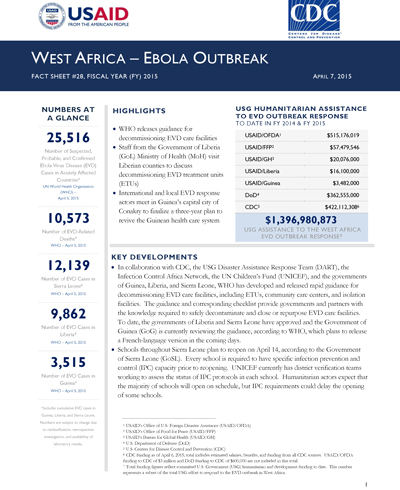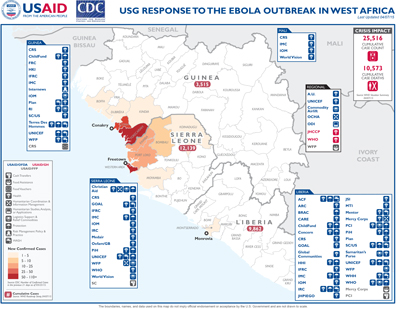April 7, 2015
HIGHLIGHTS
Ebola Response
Visit our main West Africa Ebola Outbreak page to learn more about how we're responding to the West Africa Ebola outbreak, and what you can do to help.
- WHO releases guidance for decommissioning EVD care facilities
- Staff from the Government of Liberia (GoL) Ministry of Health (MoH) visit Liberian counties to discuss decommissioning EVD treatment units (ETUs)
- International and local EVD response actors meet in Guinea’s capital city of Conakry to finalize a three-year plan to revive the Guinean health care system
West Africa Ebola Outbreak Fact Sheet #28 (FY 15) ![]() (pdf - 304k)
(pdf - 304k)
KEY DEVELOPMENTS
- In collaboration with CDC, the USG Disaster Assistance Response Team (DART), the Infection Control Africa Network, the UN Children’s Fund (UNICEF), and the governments of Guinea, Liberia, and Sierra Leone, WHO has developed and released rapid guidance for decommissioning EVD care facilities, including ETUs, community care centers, and isolation facilities. The guidance and corresponding checklist provide governments and partners with the knowledge required to safely decontaminate and close or repurpose EVD care facilities. To date, the governments of Liberia and Sierra Leone have approved and the Government of Guinea (GoG) is currently reviewing the guidance, according to WHO, which plans to release a French-language version in the coming days.
- Schools throughout Sierra Leone plan to reopen on April 14, according to the Government of Sierra Leone (GoSL). Every school is required to have specific infection prevention and control (IPC) capacity prior to reopening. UNICEF currently has district verification teams working to assess the status of IPC protocols in each school. Humanitarian actors expect that the majority of schools will open on schedule, but IPC requirements could delay the opening of some schools.
REGIONAL
Between March 22 and 29, West African countries reported a slight increase in the number of new confirmed EVD cases—82 compared to the previous week’s 79. In Guinea, EVD case incidence rose to 57 from 45 the previous week, and Sierra Leone recorded 25 confirmed EVD cases. Liberia reported no confirmed EVD cases during the same period.
Seven health workers in Guinea and one health worker in Sierra Leone contracted EVD between March 22 and 29. The total number of health worker infections reported across Guinea, Liberia, and Sierra Leone since the start of the current EVD outbreak is 861, with 495 deaths, as of April 1.
West Africa Ebola Map #28 April 7, 2015 ![]() (pdf - 515k)
(pdf - 515k)
Liberia
GoL MoH staff, accompanied by members of the DART and WHO representatives, are traveling to 14 of Liberia’s 15 counties, excluding Montserrado, to discuss with local officials and communities the decommissioning of ETUs. The county-level consultations allow MoH officials to explain the ETU decommissioning process, assess the readiness of the county to respond to a suspected EVD case in the absence of an ETU, gauge community reactions to closing ETUs, and listen and respond to questions. MoH staff plan to use the information gathered during the consultations to create a county-specific vulnerability matrix that highlights county requirements for effectively managing a suspected EVD case. The county-level consultations began during the week of March 23 in southeastern Liberia and will continue through the end of April, according to the MoH.
At a March 31 GoL Incident Management System (IMS) sub-committee meeting, the MoH presented its findings from the first two county-level consultations and outlined community- and national-level next steps, as well as general guidance for EVD responders. MoH recommended that EVD response actors prepare fully for ETU decommissioning by thoroughly reviewing the WHO decommissioning guidelines and developing a plan for the transfer of equipment in ETUs to the county health team. In addition, the MoH advised that ETU partners communicate decommissioning plans to the community and county health teams and help the individual county health teams strengthen EVD response capacity.
On April 6, the IMS officially requested that USAID/OFDA assist decommissioning efforts at three MoH-managed ETUs in Montserrado County: Island Clinic, Old Ministry of Defense, and Unity Conference Center. The IMS reports that the three sites have remained closed to patients for more than 21 days and undergone extensive decontamination procedures. The IMS request asks USAID/OFDA to support deconstructing the three facilities, relocating equipment and supplies, and transitioning the sites back to the land owners.
Sierra Leone
CDC staff report multiple instances of high-risk EVD exposure and infection occurring in hospitals in Sierra Leone. As of April 4, CDC staff were supporting investigations into an EVD patient’s death in a general hospital ward in Kambia District. In addition, CDC reports ongoing investigations into an active EVD transmission chain that had affected three health care workers as of March 29 at Bombali’s Makeni Regional Government Hospital where, according to CDC, two patients may have infected the health care workers in late February. CDC reports that nearly 300 contacts linked to the Bombali health care worker cluster remain under surveillance.
A member of the DART visited Koinadugu, Kono, and Pujehun districts on April 4 to help conduct a rapid assessment, in coordination with CDC, WHO, the International Organization for Migration (IOM), and the UN Mission for Ebola Emergency Response. In each district, the assessment team met with the officials from District Ebola Response Centers (DERCs) to discuss the current situation.
As of April 5, Koinadugu had not confirmed a new EVD case in 22 days. The district is Sierra Leone’s largest in terms of geographic area, which has impeded response efforts as some areas of the district are very remote. In addition, the Koinadugu DERC noted that market days in neighboring areas of Guinea result in regular cross-border traffic. Guinean officials have not yet signed a memorandum of understanding on cross-border issues.
Many households in Kono—which the GoSL National Ebola Response Center (NERC) reported on April 5 had reached 41 days without a new confirmed EVD case—have family ties to populations across the border in Guinea. The Kono DERC expressed concern that the scaling up of response activities in Guinea may increase the risk of cross-border transmission and noted that the remoteness of Kono’s chiefdoms impedes their capacity for isolation and treatment.
Pujehun, which borders Liberia, has not recorded a new EVD case in approximately four months, according to the NERC. However, the Pujehun DERC noted that, as the district contains a major transit route from Liberia to Guinea, the possibility of cross-border EVD transmission remains a concern. IOM, through its mobile training teams, plans to support improved IPC and health management capacity for border officials.
Guinea
The geographic area of EVD transmission has increased in addition to the slightly elevated EVD case incidence in Guinea between March 22 and 29, according to WHO. Seven Guinean prefectures reported at least one confirmed EVD case during that time as compared with three prefectures during the previous week. Fria and Siguiri prefectures reported a new confirmed EVD case—the first in more than 50 days. Siguiri, which borders Mali, is the first prefecture outside the western area of Guinea to report a confirmed case in more than 30 days.
Between April 3 and 5, the GoG and WHO recorded 11 new confirmed EVD cases—five in Conakry, three in Forécariah Prefecture, two in Kindia Prefecture, and one in Dubréka Prefecture. As of April 5, the GoG and WHO had reported 39 probable, suspected, and confirmed EVD patients seeking treatment in EVD facilities across Guinea, including eight EVD-positive patients at the Conakry ETU. At present, Guinean EVD health facilities—ETUs, transit centers, and an EVD treatment center for health care workers in Conakry—have the capacity to treat nearly 400 probable, suspect, and confirmed EVD patients.
International and local EVD response actors—including representatives from the GoG, the USG, the European Union, UNICEF, WHO, the African Development Bank, and the World Bank—met in Conakry on April 1 and 2 to finalize a three-year plan to revive the Guinean health care system. Meeting participants identified reducing high maternal and child mortality rates, decreasing the pervasiveness of communicable and non-communicable diseases, and strengthening health crises management as health care system priorities, according to WHO. Participants suggested that next steps, after receiving final approval of the plan from the GoG Ministry of Health, include completing the stimulus plan, the National Health Development Plan, and the terms of reference for partners.
From March 25 to 31, USAID/OFDA partner UNICEF, in collaboration with local partners, delivered relief items, including mosquito nets, personal protective equipment (PPE), and water, sanitation, and hygiene (WASH) kits to EVD-affected communities in Conakry and Boffa, Kindia, Kissidougou, Kouroussa, Macenta, Nzérékoré, and Siguiri prefectures. UNICEF distributed 6,000 mosquito nets in Kindia, Kissidougou, Kouroussa, Macenta, and Siguiri and provided a two-month supply of PPE to a community transit center in Kindia. In addition, UNICEF delivered 8,000 WASH kits to households in Boffa and 8,500 WASH kits to households in Nzérékoré. UNICEF has distributed a total of 280,000 WASH kits since the beginning of the West Africa EVD epidemic.
PUBLIC DONATION INFORMATION
- The most effective way people can assist relief efforts is by making cash contributions to humanitarian organizations that are conducting relief operations. A list of humanitarian organizations that are accepting cash donations for disaster responses around the world can be found at www.interaction.org.
- USAID encourages cash donations because they allow aid professionals to procure the exact items needed (often in the affected region); reduce the burden on scarce resources (such as transportation routes, staff time, and warehouse space); can be transferred very quickly and without transportation costs; support the economy of the disaster-stricken region; and ensure culturally, dietary, and environmentally appropriate assistance.
More information can be found at:
- The Center for International Disaster Information: www.cidi.org or +1.202.821.1999.
- Information on relief activities of the humanitarian community can be found at www.reliefweb.int.
USAID/OFDA bulletins appear on the USAID website at what-we-









Comment
Make a general inquiry or suggest an improvement.